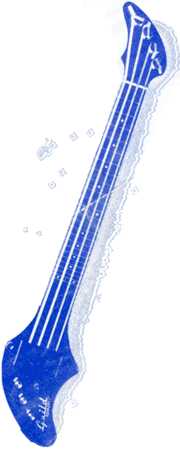Guild Instruction Sheet
The DeArmond and Fender Ashbory Basses don't come from the factory with instructions, but the Guild sure did.
Scans contributed by Mike Tavener on May 23, 2003 (introduction by Brock Frazier)
If you're looking for a user guide for the current generation Ashbory, I wrote one and it is available here.
The Ashbory is still considered by many to be radical over fifteen years later, and certainly was at the time. To help bass guitar and upright bass players transition to the Ashbory, Guild provided a two color blue and green printed guide giving basics to using the Ashbory.
Some observations about the guide:
- The tuners on the blue bass on the back are straight centered whereas many (if not all) Guild Ashborys had the curved centers.
- The DeArmond and Fender Ashbory Basses do not have the active/passive switch.
- Ashbory strings from Guild listed at the exact same price ($25) in 1987 as bass guitar strings even though this paper claims the Ashbory strings are half the cost.
- In defense of "They can last ten times as long as regular strings if they're not cut or damaged", I had a full set of Guild strings last over two years once and they still sounded great.
- The later NOS Guild Strings I purchaced were not pre-tied.
- I like to turn both the tuning peg and the tuner itself at the same time while tuning to avoid bending or breaking the fragile Guild Ashbory tuner center posts.
- Original Scan Side 1 - Restringing and tuning information. (1.1k)
- Original Scan Side 2 - "This sheet will help you understand what you're doing when you first try Guild's new Ashbory bass." (1.3k)
| I N S T R U C T I O N S F O R |
Effective June, 1987
|
Restringing the Ashbory Bass The strings for an Ashbory are different from any other type of musical instrument string. They are made of a special, high-strength material and it is therefore important to follow these instructions carefully to ensure the correct performance from them. Before putting the strings on the bass, they should first be stretched out by pulling them to approximately twice their length. They will, of course, spring buck to a length which is acceptable. Next, they should be given a light coat of either talcum or baby powder. Sprinkle a little powder in the palm of your hand and run it along the length of the strings. This gives them a smoother feel when played. Remove the bridge cover by gently pulling both sides of the cover laterally, so as to clear the protruding nibs on the bridge itself, and then lift upward. The strings have been knotted at each end to make restringing quick and easy to perform. First, turn the tuning gear so as to position the quarter moon at the left side of the string. See diagram. Next, slip the string into the capstan as shown and stretch the string towards the bridge, then hook the other end into the bridge slot. Replace bridge cover when all four strings are in place. |
How to Tune
Your Ashbory Bass The strings should now be tuned to approximately a tone below pitch. Plug your Ashbory into an amplifier and tune up to pitch by turning the tuning gears clockwise while making sure that the string winds downward on the capstan. If the Ashbory continues to go out of tune, once you have achieved pitch, simply tighten the adjustable thumbscrew located on each gear head. In the event that the preamp when switched on is not activated, first check the battery located behind the back plate. If the battery is drained or old, replace wkh a new conventional nine volt battery. This should restore the preamp. Applying some powder to the strings occasionally will help maintain a good feel and tone. CAUTION! The Ashbory preamp produces considerable gain when switched on. Due to the exceptionally low frequencies produced by your Ashbory, care should be taken either to reduce the volume level of your amp, or the volume level of the Ashbory pior to turning on the preamp switch. Ignoring this precaution could result in possible amp or speaker damage. When reordering strings, ask for set AB-400. |

How to sound like nothing you've ever heard.
The AshboryTM Bass from Guild.*
This sheet will help you understand what you're doing when you first try Guild's new Ashbory bass. No matter what kind of bass you've played before, you must learn some new playing techniques to get the best from the Ashbory. Don't expect to pick one up and get the most out of it right away. Take your time in learning the techniques required, and it will reward you with sounds that you can't get from any other instrument.
|
Attitude Think
light. Think
smooth. Think
flexible. Think
precise. |
 |
Tips
If the balance
feels unusual, For a natural
vibrato, For a warm, fat
round sound, For a punchy sound
that resembles a standard bass guitar, For a bright
percussive sound, For a true
acoustic bass sound, Ashbory strings
are softer than steel and will never corrode. |
|
*U.S. and foreign patents pending. © 1987 Guild Music Corporation |
|

